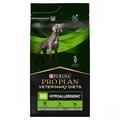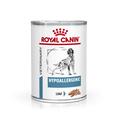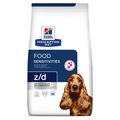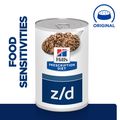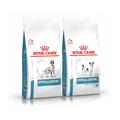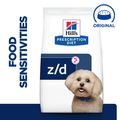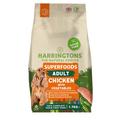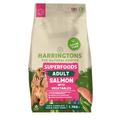Many dogs are affected by food allergies, but when it comes to identifying the particular allergen causing problems, it can be a lengthy and involved process.
Elimination Diet
To isolate the allergen, an elimination diet is needed. This should always be undertaken under the care and advice of your vet to avoid getting it wrong and making your dog’s symptoms worse.
Some symptoms, such as itchy and inflamed skin, can take weeks to develop and equally long to disappear when the problematic food source is removed, which makes the process of trial and error difficult in some cases.
Providing you’ve consulted your vet beforehand and he’s onboard with a similar approach, we would advise the following steps for conducting an elimination diet:
- The switch to a ‘safe’ diet should happen over the course of a week. Your vet will advise what this diet should be, but it’s usually something very plain, like chicken and rice. For the first two days, combine 75% of the old food with 25% of the new food, increasing to 50/50 on days three and four, and then 25% old food and 75% new food days five and six. By the seventh day, your dog should comfortably be having 100% of the new food.
- Continue with this safe diet for 8-12 weeks. If the symptoms resolve after 8 weeks, it’s time to move onto the next stage. If they haven’t resolved, speak to your vet and continue the safe diet for an additional 4 weeks (12 in total).
- Once you’re sure the symptoms have resolved themselves, feed a meal of your dog’s original diet. You’ll probably be reluctant to do this but it’s necessary in order to confirm a food allergy is definitely to blame. If symptoms return within 72 hours, then a food allergy is confirmed.
- Return to the safe diet and begin the final testing phase, whereby you introduce a new ingredient each week and watch for flair-ups. Wait three days to check for symptoms and then return to the safe diet for the rest of the week. This will reset the body in preparation for a new ingredient being introduced.
- Speak to your vet about which ingredients to test but, as you typically develop allergies to the foods you eat most, you might want to start with your dog’s most frequently eaten ingredients, such as beef or lamb. Problematic ingredients like egg, wheat and soy also need to be tested.
Once you’ve identified what’s causing the flair-ups, you know exactly what to avoid in the future. Please bear in mind that your first port of call in these situations should always be your vet, as they may suspect another type of allergy/condition is responsible – in which case, different tests will be needed.
If you have found this article helpful, you may be interested to read our other related articles: Dealing with food allergies, Allergies and skin complaints in dogs, Common skin complaints in cats, How to treat adverse food reactions in dogs, Seasonal allergies and itchy skin.
If you have any advice on conducting an elimination diet, please comment below and share it with our other readers!
Written by: Hannah

